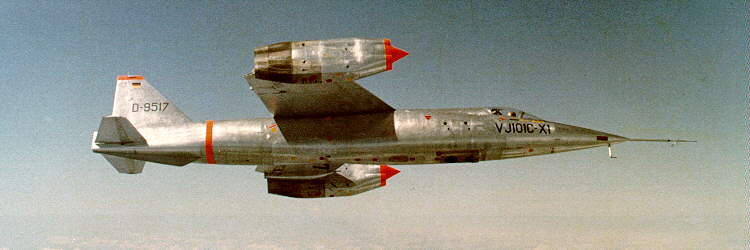|
In 1955 the ban on aircraft development and production in Germany, a result
of world war II, ended. The new Ministry of defense discussed the need
for an interceptor aircraft. The geographic situation of Germany as a NATO
front state made high top speed and climb rates necessary. In 1956 selected
companies including Heinkel and Messerschmitt began with their studies.
The increasing performance of modern supersonic jet aircraft required long
and well prepared but vulnerable runways. Therefore in autumn 1957 the
ministry claimed additional VTOL (Vertical Take-Off and Landing) capability
for the aircraft. Under the condition that Messerschmitt, Heinkel and Boelkow
work together a contract for development and construction of five prototypes
was announced. The three companies then joined works in the Entwicklungsring
Süd (EWR) in February 1959.
But within NATO a workshare was arranged which assigned the interceptor
role to the former world war allies whereas the German Luftwaffe should
target enemy aircraft on their airfields. The changed mission profile made
high fuel capacities necessary for low level flight over long distances
and led to the VJ-101 D design study. However this project was never realized
when NATO and Luftwaffe lost their interest in VTOL capability in the mid
60ies.
Nevertheless the work on the VJ-101 C continued. The X1, equipped with
six Rolls-Royce RB-145 without afterburner, made its first hover flight
in April 1963. Vertical take-off and the transition to aerodynamic flight
by swivelling the engine pods on the wing ends were safe and confirmed
the selected VTOL-concept. In July 1964 the sound barrier fell when the
aircraft reached Mach 1.08. With this flight the VJ-101 became the first
VTOL-aircraft in the world to reach supersonic speed. In September the
X1 was totally destroyed during a conventional take-off. The pilot survived
without injuries. A malfunction in an electronic system initiated the crash
but the VTOL-components where not responsible.
Ground tests with the X2 began October 1964 followed by the first hover
flight in June 1965. The major difference between the two experimental
aircraft were the engines on the wing ends of the X2. The RB 145 Rs were
equipped with afterburners. They improved the aircrafts flight performance
and take-off weight but increased the problems with recirculation of hot
gases and ground erosion during vertical take-off and landing. The X2 was
later damaged in a hard landing when the landing gear broke.To reduce the
danger of engine stalls initiated by hot gas recirculation and to avoid
the heavy ground erosion when using the afterburners a new take-off procedure,
so called RVTO - Rolling Vertical Take-Off - was developed and successfully
tested. With the engines turned 70 degrees the aircraft lifted off after
3 m rolling and reached 15 m altitude after 40 m. In the same way landings
with afterburner needed only 50 m of runway.
Meanwhile a memorandum about the joint development of weapon systems between
the German and US-government was signed. One result was the US/FRG ( FRG
= Federal Republic of Germany ) design study for an advanced V/STOL tactical
fighter weapon system (AVS) as an F-104G successor. The EWR cooperated
with the Fairchild Hiller Republic aviation division and the X2 participated
in this program as the only available flying test bed for advanced V/STOL
concepts and flight control systems. But flight-tests had to be stopped
in June 1971 when the life-time of major aircraft components ended. The
AVS program was terminated, when VTOL-capability became unimportant for
the air forces.
With the VJ-101 C, VAK-191 B and Do-31 a complete V/STOL-aircraft family
for intercept, strike and transport missions was developed. Although the
military requirements referring to the need of an interceptor with VTOL
capability had been already changed when the VJ-101 C reached the flight
test phase, the experiences from this project helped the German aviation
industry to become familiar with modern aircraft development. It allowed
the German industry to participate in the European Multi-Role Combat Aircraft
(MRCA)-project which later became the Panavia Tornado.
|
